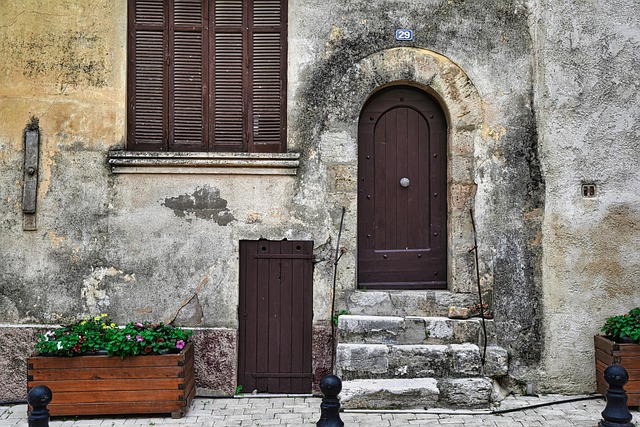Modern home design prioritizes energy-efficient window solutions like double-glazed and low-E glass windows for year-round temperature regulation. These innovations, featuring insulated frames, thermal breaks, solar-control coatings, and argon-filled glass, enhance efficiency, comfort, and noise reduction. Customized window installations with these advanced features offer substantial energy savings, weatherproofing, and cost reduction on heating and cooling bills, promoting both sustainability and a comfortable living environment.
In today’s quest for sustainable and cost-effective home design, energy-efficient window solutions are not just a trend but a cornerstone of modern construction. This article explores how strategic window installation plans, incorporating double-glazed windows, low-E glass, insulated frames, and advanced weatherproofing, can significantly enhance insulation, reduce heat transfer, and lower energy bills. Discover the benefits of these innovative technologies, known as thermal break windows, argon-filled glass windows, and solar-control solutions, in achieving optimal energy savings and a more comfortable living environment.
- Understanding Energy-Efficient Window Solutions: The Cornerstone of Modern Home Design
- Double-Glazed Windows: How They Enhance Insulation and Reduce Heat Transfer
- Low-E Glass: Unlocking the Benefits of Enhanced Thermal Efficiency
- The Role of Insulated Window Frames in Achieving Optimal Energy Savings
- Advanced Weatherproofing and Solar Control: Protecting Your Space from Extreme Conditions
Understanding Energy-Efficient Window Solutions: The Cornerstone of Modern Home Design
In today’s world, understanding energy-efficient window solutions is the cornerstone of modern home design. Double-glazed windows, for instance, offer superior insulation by trapping air between two layers of glass, significantly reducing heat transfer and minimizing drafts. Low-E (low-emissivity) glass windows are another game-changer; they reflect heat back into the home during cold months while allowing sunlight in during warmer seasons, contributing to year-round energy savings.
Insulated window frames and thermal break windows further enhance energy efficiency by preventing heat loss through the frame. Solar-control windows with special coatings or tinting help regulate indoor temperatures by blocking harmful UV rays and reducing solar heat gain. Argon-filled glass windows take this a step further, providing excellent insulation against both heat transfer and noise pollution. These energy-saving window designs not only lower utility bills but also create a more comfortable living environment.
Double-Glazed Windows: How They Enhance Insulation and Reduce Heat Transfer
Double-glazed windows are an excellent choice for those seeking energy-efficient window solutions. By incorporating two layers of low-E glass with a thermal break in between, these windows significantly enhance insulation and reduce heat transfer. This means your home stays warmer during colder months and cooler during hotter ones, leading to substantial energy savings.
The insulated window frames and argon-filled glass windows further contribute to their weatherproof nature, ensuring comfort and stability against fluctuating temperatures and extreme weather conditions. Additionally, solar-control windows help manage sunlight ingress, preventing excessive heat gain while still allowing natural light to brighten your space.
Low-E Glass: Unlocking the Benefits of Enhanced Thermal Efficiency
Low-E Glass is a revolutionary technology in the window industry, offering unparalleled energy efficiency and thermal performance. These special glasses are coated with microscopic layers that reflect heat back into the room during colder months, keeping your space warmer and more comfortable. Conversely, they reflect heat away from the interior during hotter seasons, acting as an insulator against excessive heat gain. This dual functionality makes low-E glass a cornerstone of modern energy-efficient window solutions.
By integrating double-glazed windows with low-E coating, along with insulated window frames and thermal breaks, you can significantly reduce energy consumption for heating and cooling. Solar-control properties further enhance comfort by mitigating the effects of direct sunlight, preventing heat gain while still allowing natural light to brighten your space. Argon-filled glass within these windows adds an extra layer of insulation, contributing to a more stable indoor environment and reduced carbon footprint—the ultimate in weatherproof window designs.
The Role of Insulated Window Frames in Achieving Optimal Energy Savings
Customized window installation plans often incorporate insulated window frames to achieve optimal energy savings. These frames play a pivotal role in enhancing the efficiency of energy-efficient window solutions, such as double-glazed windows and low-E glass windows. By creating a thermal break between the interior and exterior environments, they significantly reduce heat transfer, keeping homes warmer in winter and cooler in summer. This results in lower heating and cooling costs, making them an essential component in any well-designed energy-saving window designs.
Moreover, insulated window frames contribute to the overall weatherproofing capabilities of windows, protecting against drafts and moisture intrusion. Solar-control windows equipped with argon-filled glass further enhance this effect, minimizing solar heat gain while maintaining comfortable indoor temperatures. These advanced features make modern window installations more than just aesthetic improvements; they are practical solutions that offer both comfort and significant long-term savings on energy bills.
Advanced Weatherproofing and Solar Control: Protecting Your Space from Extreme Conditions
Customized window installation plans often include advanced weatherproofing and solar control features, ensuring your space remains protected from extreme conditions while enhancing energy efficiency. Double-glazed windows, for instance, offer superior insulation by trapping air between two panes of glass, significantly reducing heat transfer. Low-E (low-emissivity) glass windows are another innovative solution, as they reflect heat back into the room during cold months and keep heat out during hot ones, contributing to energy savings.
Insulated window frames and thermal break windows further strengthen the barrier against weather, preventing drafts and minimizing temperature fluctuations. Energy-saving window designs often incorporate argon-filled glass, which acts as an additional insulator, enhancing overall thermal performance. These features not only make your home more comfortable but also help reduce energy bills, making them ideal choices for anyone seeking both practical and sustainable solutions.
In conclusion, modern home design prioritizes energy-efficient window solutions for their significant role in enhancing insulation, reducing heat transfer, and achieving optimal energy savings. Double-glazed windows, low-E glass, insulated frames, thermal break designs, argon-filled glass, and advanced weatherproofing/solar control technologies work synergistically to create comfortable indoor environments while minimizing utility costs. By integrating these innovative window features, homeowners can enjoy year-round comfort, preserve interior conditions, and contribute to a more sustainable future.
